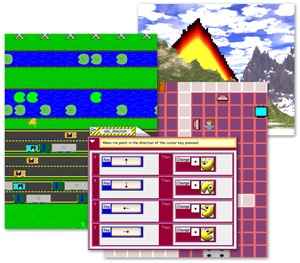AgentSheets facts for kids

The AgentSheets program lets you build games and animations.
|
|
| Paradigm | Object-oriented |
|---|---|
| Designed by | Alexander Repenning |
| First appeared | 1991 |
| Stable release |
4.0 / May 19, 2014
|
| Platform | JVM |
| License | proprietary |
| Influenced by | |
| Lisp, Logo, Smalltalk | |
| Influenced | |
| Etoys, Scratch | |
AgentSheets is a special type of block-based programming language made for kids and teens. It helps you create your own games and animations. AgentSheets uses a simple drag-and-drop system. You can put together command blocks, like "if this happens, then do that," to build a program.
The main parts of AgentSheets are called "agents." These are like characters or objects in a game. You give them rules to follow. Using these rules, agents can react to things you do, like clicking the mouse or even recognizing your voice. Agents can also move, make sounds, open websites, and solve math problems.
History of AgentSheets
The idea for AgentSheets started back in 1989 at the University of Colorado. By 1991, you could program simple things. For example, you could make a train agent follow a set of train tracks. This was done by showing the program what to do through examples.
In 1996, AgentSheets became a product that people could buy. This was possible with help from the National Science Foundation. Over time, new features were added, like speech recognition on Mac computers and 3D graphics. The program was also translated into other languages, such as Japanese and Greek. A newer version, AgentSheets 3, was released in 2010.
AgentSheets was used in a program called Scalable Game Design. This program helped many students learn about technology. In some schools, over 900 students a year took part, and more than half of them were girls. Most of these students really enjoyed learning to design games.
How AgentSheets Works
The drag-and-drop language in AgentSheets was designed to be easy for students to use. Think of it like a special kind of spreadsheet. Instead of just holding numbers and words, this grid holds your "agents."
Agents are the interactive objects you program. They look like pictures and can be animated. You can make them react when you use the mouse or keyboard. On Mac computers, they could even listen to and understand voice commands.
See also
- Web-based simulation (WBS)
- Scratch (another popular block-based programming language)

